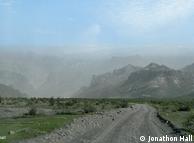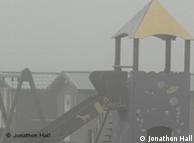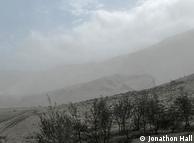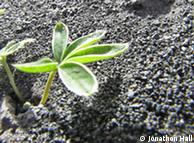TOURISM | 07.06.2010
A first look inside Iceland's ash wasteland
Few people outside of Iceland would have heard of Porsmork. The author J.R.R Tolkien used this isolated area as the basis for some of the locations in his famous Lord of The Rings novels. In April this untouched wilderness was the location of its own blockbuster when the nearby Eyjafallajokull volcano erupted.
"This is totally different to what it was at the same time last year. It's not supposed to be all gray and colorless … it's known for the bright colors," said Arsaell Hauksson as we drove through a depressing lunar landscape.
I had come to see the volcano which caused so much chaos and shut down airspace across Europe. On Thursday, with Hauksson as my guide, I was one of the first people allowed into the heart of Iceland's ash wasteland.
 Tourism in Vatnajokull National Park has taken a dive since the eruption
Tourism in Vatnajokull National Park has taken a dive since the eruption
Our destination Porsmork, lay inside the Vatnajokull National Park, which had been off limits since the eruption began. It used to be a magnet for nature lovers, and its campsites are normally bustling at this time of year.
"This was going to be the best tourist summer we ever had … we thought that, but now …" Hauksson left his sentence unfinished and gestured towards the growing ash cloud outside. This trip was the first time he had returned to the park since the eruption.
The 27-year-old father runs his own farm at the base of the volcano. He is also a member of Iceland's search-and-rescue squad and a tour guide. He's seen how the volcano has impacted his community but remains upbeat, his speech punctuated by frequent laughter.
Scientists at the University of Iceland estimate around 300 million cubic meters of rock and ash was ejected from Eyjafallajokull during the eruption. What wasn't blown across Europe settled in the area surrounding the glacier, transforming it into an ocean of gray and leading to inevitable comparisons to the moon.
"It's funny because NASA actually sent the first astronauts to Iceland to prepare them for what it would be like to land on the moon," Hauksson said.
 Many Icelanders accept volcanic eruptions as part of life
Many Icelanders accept volcanic eruptions as part of life
A changing landscape
The eruption appears to have stopped, but the ash problem remains as strong winds pick up huge columns of the choking dust and move it around.
As we drove into the just re-opened national park, we passed a lone bulldozer, creating its own plume as it scraped a new road through mounds of ash.
We headed to the north of the glacier, where the full fury of the eruption was unleashed. A massive torrent of melted glacial water thundered down the mountain, sweeping away everything in its path.
Hauksson points out rivers that have changed their course and boulders the size of cars that have been tossed around by flooding. At several points the ash in the air was so thick we had to slow to a crawl as we could no longer see anything.
"It is strange, this landscape I am familiar with and still know where I am, but I can now say it's an area I have never been before because it has so totally changed."
But locals know volcanic activity is simply a part of life in Iceland.
"This area has been hit by floods over centuries and this area is all volcanic, it's been shaken by the glaciers and eruptions of older times and now this eruption," he said.
The air cleared enough for us to get out of the car at the popular picnic spot Stakkholtsgja. Two wooden picnic tables protrude from the ash. Beyond them is a rocky crater that was a glacial lake before the eruption.
We listened to steam venting from the volcano above us and were forced to retreat when the wind picked up, showering us with tiny jagged black rocks that clung to our clothes and hair.
 In the worst hit area, the few trees that survived the flooding are blanketed in ash
In the worst hit area, the few trees that survived the flooding are blanketed in ash
As we continued driving we passed into an area of sunshine, free of wind and ash. We caught a glimpse of what this area must have been like, trees and tall green mountains set against a clear blue sky.
It was those pristine views that once brought visitors to our final stop, a camping ground at the base of the volcano.
"They had no ash here until the last few days of the eruption when the wind changed," Hauksson explained.
Specks of green
But now the brightly painted children's playground and rows of cabins sit abandoned in the grey grime, waiting for summer visitors who won't be coming.
"We will still have tourists who want to come and see it, visitors would like to come here, but you would not like to sleep here, so it will not be the same."
Hauksson said it will take time for the land to heal, but it will recover. All across the ash plain tiny green shoots have emerged, the first sign the recovery is beginning.
Author: Jonathon Hall
Editor: Nancy Isenson dw


No comments:
Post a Comment